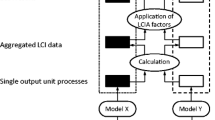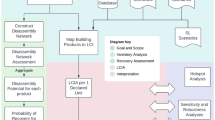Abstract
Background, aim and scope
The reliability of the results of Life Cycle Assessment (LCA) studies is highly dependent on the appropriateness of the data that are used for Life Cycle Inventory (LCI) modelling. In practice, the modelling of background systems is commonly based on generic data—which are often outdated and rarely provide information on the current situation in a representative manner. Meanwhile, an increasing number of policy directives, international agreements and national legislations to regulate the reporting of environmentally relevant data for companies and economies entered into force over the past few years. The purpose of this study is, therefore, to compare data reported in such a manner from selected sources with detailed existing generic LCI data and to evaluate their usability as a reference for LCI modelling on a unit process level. Depending on the scope of the selected reports, the study reflects considerations on a national scale.
Materials and methods
Selected data from an existing LCI study are compared with data from environmental reporting approaches, in order to analyse the degree of variation between generic data and related reporting data. Two selected reporting obligations are described in more detail and characterised methodologically from the LCI perspective: (1) the ‘United Nations Framework Convention on Climate Change’ (UNFCCC) and (2) the European Union’s Directive on ‘Integrated Pollution Prevention and Control’ (IPPC). The national data that can be derived from these two reports are compared with generic LCI data provided by the ‘Environmental Profile Report for the European Aluminium Industry’ from European Aluminium Association (EAA).
Results
The number of processes and elementary flows is originally different across the three data sources due to divergent system boundaries. Therefore, in order to perform the comparison against a common reference, the analysis is done at a unit process level: only the emissions featured in all three sources are analysed (i.e. emissions of CO, CO2, PFCs and SO2 resulting from anode production, electrolysis and cast house). The comparison of data from this limited number of processes shows differences across the three data sources.
Discussion
A key reason for the differences is the divergent scopes considered in the different data sets (i.e. geographical coverage and time period). Still, despite the differences in scale and scope, the deviation between the data from IPPC and EAA is found to be within reasonable and acceptable margins—especially when also the different technological conditions are considered. Thus, the dataset of EAA is judged to be reliable—within its original scope. However—with the exception of PFCs—the differences between the data from the EAA report and those derived from UNFCCC cannot be explained this way.
Conclusions
This study exemplifies drawbacks and opportunities of the usability of data from environmental reporting as a national reference for existing LCI data. By comparing reporting data and existing LCI data, deviations can be explained and inappropriate or outdated data can be detected. For this procedure, knowledge about temporal coverage and individual system boundaries of the data is required. Also, expert knowledge about the processes themselves and technologies applied within these is indispensable, in order to explain differences between data sources.
Recommendations and perspectives
From an LCA perspective, the referencing of generic LCI data provides an important informative basis to focus data collection and update. However, inconsistencies due to the limited amount of elementary flows covered in reporting still need to be resolved—keeping in mind the individual aim of the study. Additional data from upcoming Pollutant Release and Transfer Registers provide a promising perspective.




Similar content being viewed by others
References
Azapagic A (1996) Environmental system analysis: the application of linear programming to life cycle assessment, vol. 1. PhD thesis, University of Surrey
Boguski TK (2000) Evaluation of Public Databases as Sources of Data for Life Cycle Assessments. EPA 60/R-00/019. US Environmental Protection Agency
Curran MA (2007) Co-product and input allocation approaches for creating life cycle data: a literature review. Int J Life Cycle Assess 12(Special Issue 1):65–78
Dittmeyer R, Keim W, Kreysa G, Oberholz A (eds) (2006) Winnacker-Küchler Chemische Technik—Prozesse und Produkte, Band 6a Metalle, 5. Auflage, Wiley, Weinheim
Europäisches Schadstoffemissionsregister (2007) URL: http://www.eper.de, accessed: 2007-07-18
European Aluminium Association (2000) Environmental Profile Report for the European Aluminium Industry, Brussels
European Aluminium Association (2005) Environmental Profile Report for the European Aluminium Industry Primary Aluminium update—Year 2002, Brussels
European Commission (1996) Council Directive 96/61/EC concerning integrated pollution prevention and control (IPPC)
European Commission (2000a) Commission Decision 2000/479/EC of 17 July 2000 on the implementation of a European pollutant emission register (EPER) according to Article 15 of Council Directive 96/61/EC concerning integrated pollution prevention and control (IPPC)
European Commission (2000b) Directorate-General for Environment, Guidance Document for EPER-Implementation
European Commission Office for Official Publications (1998) NOSE nomenclature for sources of emissions—manual, Version 1.0, Luxembourg
Eurostat (2007) URL: http://ec.europa.eu/eurostat/ramon/index.cfm?TargetUrl=DSP_PUB_WELC, accessed: 2007-07-13
Frees N (2008) Crediting aluminium recycling in LCA by demand or by disposal. Int J Life Cycle Assess 13(3):212–218
Gesamtverband der Aluminiumindustrie e.V. (2007) URL: http://www.aluinfo.de, accessed: 2007-07-18
Grjotheim K, Welch BJ (1988) Aluminium Smelter Technology. Aluminium Verlag, Düsseldorf
Guinée JB (ed) (2002) Handbook on life cycle assessment: operational guide to the ISO standards. Springer, Dordrecht
Hirt W, Wilkening S (1981) Bedeutung der Vibrationsabformung von Kohlenstoff-Anoden für die Aluminiumelektrolyse. Aluminium 57(10):663–668
Huijbregts J et al (2001) Framework for modelling data uncertainty in life cycle inventories. Int J Life Cycle Assess 6(3):127–132
International Aluminium Institute (2006a) The Aluminium Sector Greenhouse Gas Protocol—Greenhouse Gas Emissions Monitoring and Reporting by the Aluminium Industry
International Aluminium Institute (2006b) The International Aluminium Institute Report on the Aluminium Industry’s Global Perfluorcarbon Gas Emissions Reduction Programme—Results of the 2004 Anode Effect Survey
International Organization for Standardization (2006a) EN ISO 14040—Environmental Management—Life Cycle Assessment—Requirements and Guidelines
International Organization for Standardization (2006b) EN ISO 14044—Environmental Management—Life Cycle Assessment—Requirements and Guidelines
IPCC (Intergovernmental Panel on Climate Change) (1996) Revised 1996 Guidelines for National Greenhouse Gas Inventories
IPCC (Intergovernmental Panel on Climate Change) (2001) Good Practice Guidance and Uncertainty Management in National Greenhouse Gas Inventories
Koch M, Harnisch J (2002) CO2 emissions related to the electricity consumption in the European primary aluminium production. Int J Life Cycle Assess 7(5):283–289
Martcheck KJ (2006) Modelling more sustainable aluminium. Int J Life Cycle Assess 11(1):34–37
Organisation of European Aluminium Refiner and Remelters (2007) URL: http://www.oea-alurecycling.org/, accessed 2007-07-18
Rydberg T, Bauer C, Wursthorn S (2005) Appropriate data and methodology in LCA in relation to intended application, SETAC Europe 15th Annual Meeting, 22.05.–26.05.2005, Lille, Book of Abstracts, pp 61–62
Schlimbach J (2003) Technische Potentiale der Primäraluminiumproduktion. PhD thesis, RWTH Aachen
Schminke E, Grahl B (2007) The part of LCA in ISO type III environmental declarations. Int J Life Cycle Assess 12(Special Issue 1):38–45
Schwarz W (2005) Daten von H-FKW, FKW und SF6 für die nationale Emissionsberichterstattung gemäß Klimarahmenkonvention für die Berichtsjahre 2004 und 2005. 1. Zwischenbericht zum Forschungsvorhaben
Schwarz W (2005) Emissionen und Emissionsprognosen von H-FKW, FKW und SF6 in Deutschland—Aktueller Stand und Entwicklung eines Systems zur jährlichen Ermittlung. Forschungsbericht
Tabereaux AT (1994) Anode effects, PFCs, global warming and the aluminium industry. JOM 46(11):30–34
Tillmann AM (2000) Significance of decision-making for LCA methodology. Environ Impact Asses 20:113–123
Umweltbundesamt (2006) Berichterstattung unter der Klimarahmenkonvention der Vereinten Nationen 2006—Nationaler Inventarbericht, Dessau
Umweltbundesamt (2007) Berichterstattung unter der Klimarahmenkonvention der Vereinten Nationen 2007—Nationaler Inventarbericht, Dessau
United Nations Economic Commission for Europe (1998) Aarhus Convention on Access to Information, Public Participation in Decision-making and Access to Justice in Environmental Matters
United Nations Economic Commission for Europe (2003) Kiev Protocol on Pollutant Release and Transfer Registers to the UNECE Convention on Access to Information, Public Participation in Decision-making and Access to Justice in Environmental Matters
Warsen J, Bauer C, Schebek L (2007) LCI modelling for material development—exploring the use of reporting data. In: Weil et.al. (eds), Materials design and systems analysis, workshop proceedings May 16–18, 2006, Forschungszentrum Karlsruhe, Germany, Shaker Verlag Aachen, pp 133–148
WirtschaftsVereinigung Metalle (2005) Metallstatistik 2004
Author information
Authors and Affiliations
Corresponding author
Additional information
Responsible editors: Gerald Rebitzer, Jörg Schäfer
Special Issue “Life Cycle Performance of Aluminium Applications”.
Rights and permissions
About this article
Cite this article
Warsen, J., Bauer, C. & Schebek, L. Usability of national reporting data as a reference for generic unit processes. Int J Life Cycle Assess 14 (Suppl 1), 52–61 (2009). https://doi.org/10.1007/s11367-009-0070-z
Received:
Accepted:
Published:
Issue Date:
DOI: https://doi.org/10.1007/s11367-009-0070-z




